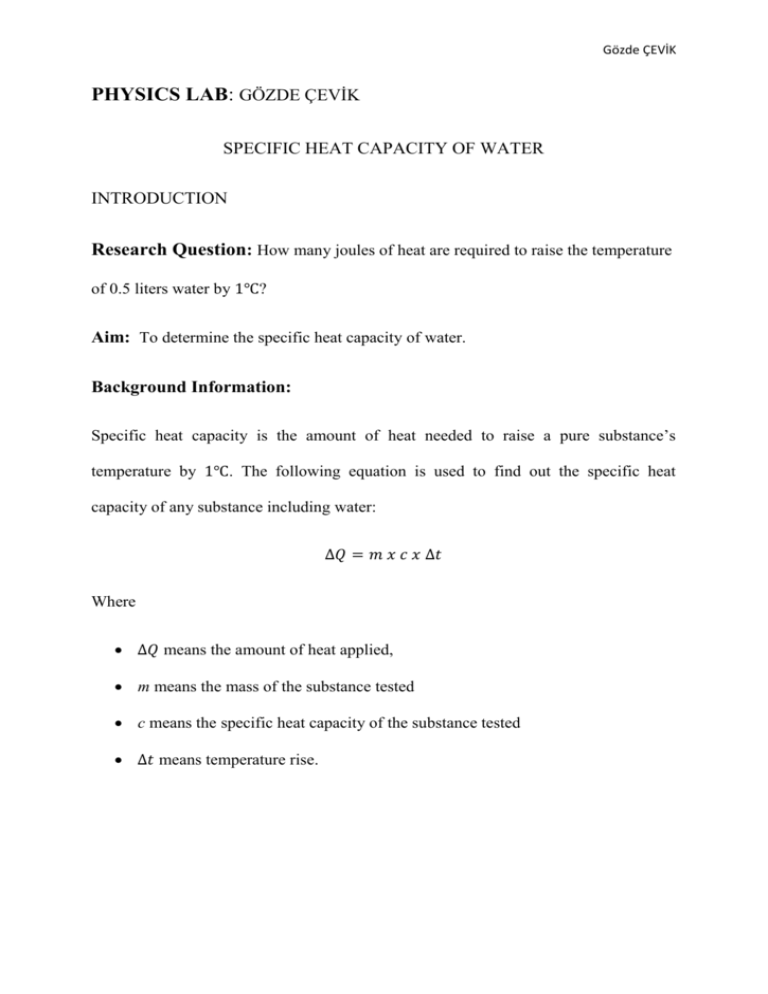Specific Heat Capacity of Water Lab Report
advertisement

Gözde ÇEVİK PHYSICS LAB: GÖZDE ÇEVİK SPECIFIC HEAT CAPACITY OF WATER INTRODUCTION Research Question: How many joules of heat are required to raise the temperature of 0.5 liters water by 1℃? Aim: To determine the specific heat capacity of water. Background Information: Specific heat capacity is the amount of heat needed to raise a pure substance’s temperature by 1℃. The following equation is used to find out the specific heat capacity of any substance including water: ∆𝑄 = 𝑚 𝑥 𝑐 𝑥 ∆𝑡 Where ∆𝑄 means the amount of heat applied, m means the mass of the substance tested c means the specific heat capacity of the substance tested ∆𝑡 means temperature rise. Gözde ÇEVİK In this experiment, certain amounts of water placed in a kettle are heated for specified time intervals before and after their temperatures are measured. The power of the kettle is learnt before the experiment to measure the amount of heat applied (∆𝑄) and the power of it is 1000 watts. Hypothesis: Since the specific heat capacity of a substance is the same for all conditions, the 4 different testings will give the same/close value of specific heat capacity of water under the same conditions. Independent Variables: 1. The amount of water used (0.5 liters) 2. The initial temperature of water used 3. The power of the boiler used (1000 Watts) Dependent Variables: 1. The temperature rises of water for each case 2. The final temperatures of water for each case 3. The amount of heat applied. Controlled Variables: 1. Time 2. Room temperature How the variables are controlled: The whole experiment is done in a place that was in room temperature and had the same air conditions throughout the experiment. Gözde ÇEVİK DESIGN Apparatus: 1. Tap water 2. Graduated kettle 3. Centigrade thermometer Method: 1. The power of kettle is noted down before the experiment. 2. Half liter of water is poured from the tap to the kettle for the first measurement. 3. The temperature of the water in the kettle is measured by using a thermometer. 4. The initial temperature is recorded 5. The kettle is turned on and the water is heated for 30 seconds. 6. After 30 seconds, the kettle is turned off and immediately the final temperature of water is recorded. 7. The steps 2-5 are repeated for the second, third and fourth measurements but the time for heating is changed to 60 , 90 and 120 seconds respectively. 8. The values are recorded. Gözde ÇEVİK DATA AND PROCESSING Raw Data Table 1: The initial and final temperatures recorded for the four trials. INITIAL TEMPERATURE (℃ ± FINAL TEMPERATURE 0.5) (℃ ± 0.5) 1st trial 27 ± 0.5℃ 37 ± 0.5℃ 2nd trial 23 ± 0.5℃ 47 ± 0.5℃ 3rd trial 17 ± 0.5℃ 53 ± 0.5℃ 4th trial 13 ± 0.5℃ 63 ± 0.5℃ TESTINGS Processed Data Table 2: The temperature rise of the four trials Initial Temperature Final Temperature (℃ ± 0.5) Temperature (℃ ± 0.5) Rise (℃ ± 0.5) 1st trial 27 ± 0.5℃ 37 ± 0.5℃ 10 ± 0.5℃ 2nd trial 23 ± 0.5℃ 47 ± 0.5℃ 24 ± 0.5℃ 3rd trial 17 ± 0.5℃ 53 ± 0.5℃ 36 ± 0.5℃ 4th trial 13 ± 0.5℃ 63 ± 0.5℃ 50 ± 0.5℃ TESTINGS Finding out the specific heat capacity of water: In order to find out the specific heat capacity of water, the energy applied to all trial samples must be measured first. Gözde ÇEVİK 𝑒𝑛𝑒𝑟𝑔𝑦 = 𝑝𝑜𝑤𝑒𝑟 𝑥 𝑡𝑖𝑚𝑒 1st Trial: 1000 W x 30 sec. = 30000 J is ∆𝑄 1 ∆𝑄 = 𝑚 𝑥 𝑐 𝑥 ∆𝑡 c= 2nd Trial: 30000 0.5 𝑥 10 𝑚 𝑥 ∆𝑡 1000 W x 60 sec. = 60000 J is ∆𝑄 2 c= 60000 0.5 𝑥 24 so c = ∆𝑄 𝑚 𝑥 ∆𝑡 = 5000 joule/ gram ℃ 1000 W x 90 sec. = 90000 J is ∆𝑄 3 ∆𝑄 = 𝑚 𝑥 𝑐 𝑥 ∆𝑡 c= 4th Trial: ∆𝑄 = 6000 joule/ gram ℃ ∆𝑄 = 𝑚 𝑥 𝑐 𝑥 ∆𝑡 3rd Trial: so c = 90000 0.5 𝑥 36 so c = ∆𝑄 𝑚 𝑥 ∆𝑡 = 5000 joule/ gram ℃ 1000 W x 90 sec. = 90000 J is ∆𝑄 4 ∆𝑄 = 𝑚 𝑥 𝑐 𝑥 ∆𝑡 c= 90000 0.5 𝑥 50 so c = ∆𝑄 𝑚 𝑥 ∆𝑡 = 4800 joule/ gram ℃ Gözde ÇEVİK Table 3: The specific heat capacity for 4 trials and the mean of them TRIAL NO: Specific Heat Capacity ( joule/ gram ℃) 1st 6000 2nd 5000 3rd 5000 4th 4800 The Mean 5200 CONCLUSION AND EVALUATION At the end of this experiment, the specific heat capacity of water is found 5200 joule/ gram℃. However, specific heat capacity of water is 4.186 joule/gram °C according to the physics data booklet. The value that’s found at the end of this experiment is much bigger than the actual value. This may be caused because of the heat loss to the surroundings during the experiment and using isolation may prevent this loss. Using more precise thermometer is also an improvement, especially a digital thermometer to prevent the false measurements.







